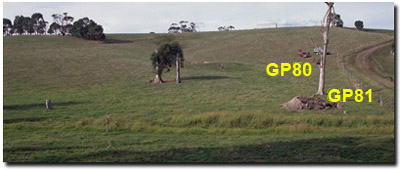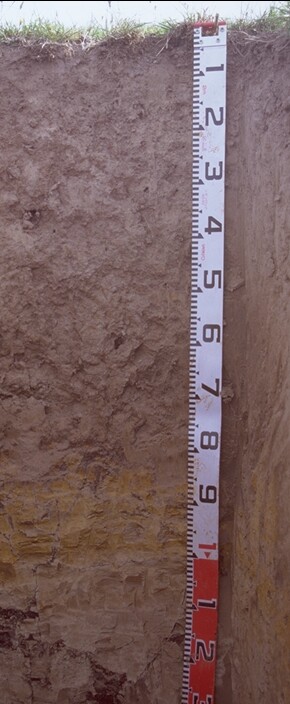GP80
| Location: Athlone | Aust. Soil Class.: Bleached-Acidic, Eutrophic, Brown DERMOSOL |
| Geology: Cretaceous sandstone. | |

GP80 Landscape
Soil Profile Morphology:
Surface Soil
| A1 | 0-8 cm | Very dark brown (10YR 3/2); very fine sandy clay loam; moderate to strong (3 mm) polyhedral structure; firm consistence (dry); pH 4.8; abrupt change to: |  GP80 Profile |
| A2 | 8-20 cm | Dark yellowish brown (10YR 4/4) conspicuously bleached (10YR 7/2 dry); fine sandy clay loam; weak (6 mm) blocky structure; very firm consistence (dry); pH 4.8; clear change to: | |
| A22 | 20-40 cm | Dark yellowish brown (10YR 4/4); conspicuously bleached (10YR 7/2 dry) colour; very fine sandy clay loam; weak very coarse blocky structure; very firm consistence (dry); pH 5.0; clear change to: | |
| Subsoil | |||
| B1 | 45-60 cm | Yellowish brown (10YR 5/4) with yellowish brown (10YR 5/6) mottles (20%); clay loam; weak to moderate coarse blocky structure; firm consistence (dry); pH 5.1; clear change to: | |
| B21 | 60-75 cm | Yellowish brown (10YR 5/4) with strong brown (10YR 5/8) mottles; sandy clay; medium coarse blocky parting to weak medium blocky structure; pH 5.2; clear change to: | |
| C | 75 cm | Mottled rock. | |
Key Profile Features:
- Gradual increase in dry content with depth down the profile.
pH | Salinity Rating | |||
Surface (A1 horizon) | Very Strongly Acid | Very Low | Non-Sodic | None |
Subsoil (B21 horizon) | Strongly Acid | Very Low | Non-Sodic | None |
Deeper Subsoil (at 60-75 cm) | Strongly Acid | Very Low | Non-Sodic | None |

Horizon | Horizon Depth | pH (water) | pH CaCl2 | EC 1:5 | NaCl | Exchangeable Cations | |||
Ca | Mg | K | Na | ||||||
Meq/100g | |||||||||
A1 | 0-8 | 4.8 | 4.2 | 0.13 | 6.0 | 3.0 | 0.49 | 0.26 | |
A21 | 8-20 | 4.8 | 4.1 | <0.05 | 3.2 | 2.5 | 0.25 | 0.14 | |
A22 | 20-40 | 5.0 | 4.1 | <0.05 | 1.7 | 2.7 | 0.25 | 0.17 | |
B1 | 40-60 | 5.1 | 4.2 | <0.05 | 1.8 | 4.5 | 0.26 | 0.29 | |
B21 | 60-75 | 5.2 | 4.6 | 0.06 | 3.5 | 7.9 | 0.37 | 0.61 | |
Horizon | Horizon Depth | Ex Al mg/kg | Ex Ac meq/100g | Field pF 2.5 | Wilting Point pF4.2 g/100g | Coarse Sand (0.2-2.0mm) % | Fine Sand (0.02-0.2mm) % | Silt (0.002-0.02mm) % | Clay (<0.002mm) % |
A1 | 0-8 | 170 | 23 | 42.7 | 13.2 | 2.8 | 29.2 | 32.5 | 22.5 |
A21 | 8-20 | 390 | 19 | 36.2 | 21.9 | 0.8 | 34.1 | 36.0 | 24.5 |
A22 | 20-40 | 490 | 16 | 33.1 | 11.9 | 0.7 | 35.0 | 36.5 | 24.0 |
B1 | 40-60 | 410 | 15 | 32.2 | 11.5 | 0.4 | 33.2 | 35.5 | 28.5 |
B21 | 60-75 | 510 | 20 | 38.9 | 13.6 | 0.3 | 27.3 | 30.5 | 38.5 |
Whole Profile
- High levels of exchangeable aluminium (increasing to very high levels in deeper subsoil) which will restrict the growth of aluminium sensitive species. High levels of aluminium will also test to "fix” phosphorus and make it less available to plants (and therefore reduce the effectiveness of applied phosphorus fertiliser). Raising the pH levels of the soil by liming will help reduce the level of exchangeable aluminium. A lime test (samples across the whole paddock) may be appropriate to determine the amount of lime needed to raise pH. Other factors need to be considered however before lime is recommended (e.g. species growth, method of application, long trial response, likely cost benefit).


